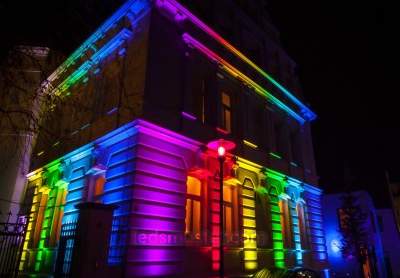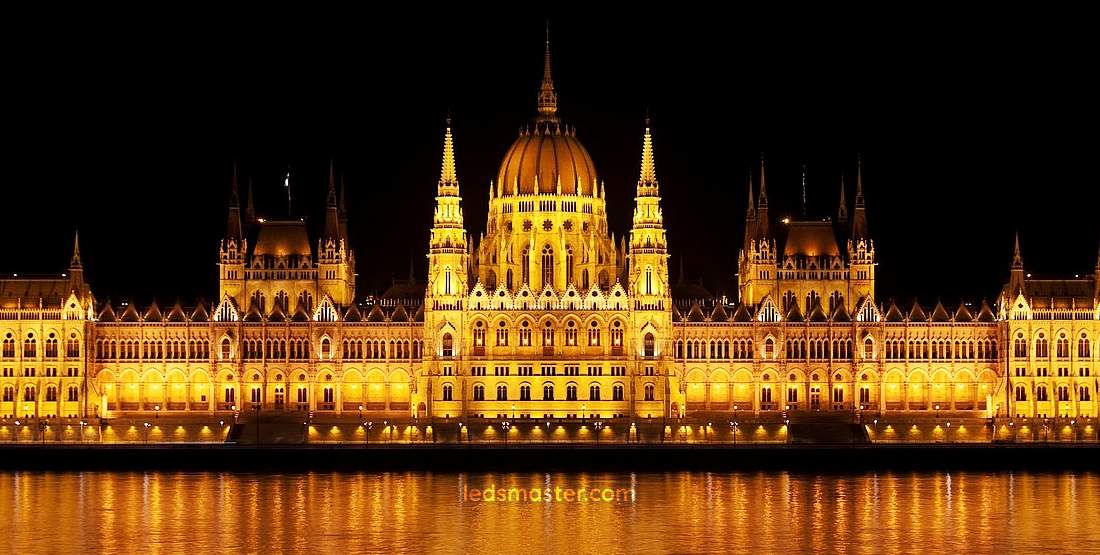Welcome to the future of architectural illumination – where innovation meets aesthetics seamlessly. Discover our cutting-edge LED building lighting solutions designed to transform ordinary structures into extraordinary visual experiences. Whether you’re looking to highlight architectural details, create dynamic color effects, or enhance sustainability with state-of-the-art technology, this page is your gateway to illuminating possibilities. Join us as we illuminate your vision with precision and style.
Building facade lights refer to the installation of exterior lighting systems designed to illuminate and enhance the visual appeal of a building’s outer walls. By employing these lights, you can transform your building facade with vibrant and dynamic colors, creating a captivating visual display. Whether it’s through the use of color-changing flood lights or static facade lights, the possibilities are extensive, offering up to 16 million colors to choose from.
Prominent examples of this application can be seen in iconic structures such as the Empire State Building and the Bank of China Tower, where the strategic use of facade lighting enhances their architectural beauty and makes them landmarks in their own right.
Beyond large-scale projects, we also specialize in providing tailored lighting solutions for smaller architecture, ensuring that every building, regardless of size, can benefit from the dramatic impact of well-designed facade lighting. Whether for commercial, residential, or public buildings, our solutions are crafted to bring out the best in architectural features, creating stunning visual experiences that leave a lasting impression.
Get your complimentary lighting design today
LEDs, or Light Emitting Diodes, have rapidly gained popularity in architectural lighting due to their long lifespan, energy efficiency, and flexibility in design. Unlike traditional lighting sources such as incandescent or fluorescent lights, LEDs emit light through a semiconductor material, which allows for precise control over color and intensity.
Table of Contents
Toggle A standout feature of LED building lights is their ability to change colors dynamically. This capability is achieved through RGB (Red, Green, Blue) LEDs, which can produce a wide spectrum of colors by varying the intensity of each primary color. Color-changing LED lights are often used to create visually striking effects, transforming the appearance of buildings throughout the day and night. For example, a building facade can transition from warm tones during sunset to vibrant hues at night, enhancing its visibility and attractiveness.
A standout feature of LED building lights is their ability to change colors dynamically. This capability is achieved through RGB (Red, Green, Blue) LEDs, which can produce a wide spectrum of colors by varying the intensity of each primary color. Color-changing LED lights are often used to create visually striking effects, transforming the appearance of buildings throughout the day and night. For example, a building facade can transition from warm tones during sunset to vibrant hues at night, enhancing its visibility and attractiveness.
Effective control systems are crucial for maximizing the potential of LED building lights. Modern control technologies allow for precise management of lighting operations, including color selection, brightness adjustment, and scheduling. Centralized control systems, often integrated with smart building technologies, enable building owners to create custom lighting scenarios tailored to specific events or seasons. Wireless protocols such as DMX (Digital Multiplex) and DALI (Digital Addressable Lighting Interface) facilitate seamless communication between light fixtures and control devices, offering flexibility and ease of operation.
LED building lights find diverse applications across various types of architecture, ranging from commercial skyscrapers to residential developments and cultural institutions. In urban landscapes, LED lights are used to accentuate architectural features, highlight building entrances, and create dynamic visual landmarks. Cultural landmarks and historical buildings benefit from LED lighting’s ability to enhance their nighttime presence while preserving their architectural integrity.
In addition to their aesthetic and functional benefits, LED building lights contribute to sustainability efforts by reducing energy consumption and minimizing light pollution. The directional nature of LED light allows for precise light distribution, minimizing wasteful spillage and glare. Furthermore, LEDs can be integrated with renewable energy sources such as solar panels, further reducing their carbon footprint and promoting environmentally responsible lighting practices.

Successful integration of LED building lights into architectural design requires careful consideration of factors such as color temperature, light output, and fixture placement. Architects and lighting designers collaborate to create lighting schemes that enhance the building’s form and function while ensuring compliance with lighting regulations and standards. Mockups and simulations are often used to evaluate the visual impact of proposed lighting designs before implementation, ensuring that the final result meets aesthetic and performance expectations.
In the realm of architectural lighting, building lights designed for facade decoration play a crucial role in enhancing the visual appeal and functionality of buildings. This section explores the key features and benefits of LED building lights, specifically tailored for facade decoration applications.
LED technology offers significant energy savings compared to traditional metal halide lamps. With an impressive energy efficiency of 140 lumens per watt (lm/W), LEDs outperform metal halide lamps, which typically only achieve around 75 lm/W. This efficiency translates to approximately 75% energy savings when using LED building lights, making them a cost-effective and environmentally friendly choice for architectural illumination.
A critical advantage of LED building lights is their extended lifespan, significantly impacting maintenance costs and operational reliability. LED flood lights from LedsMaster boast an impressive lifespan of up to 120,000 hours. This longevity ensures that once installed for outdoor building facade lighting, minimal maintenance and replacement are required over the fixture’s lifetime. For instance, operating the lights for 8 hours per day could potentially provide over 40 years of service, highlighting the durable and dependable nature of LED technology for architectural applications.
Efficient heat dissipation is paramount for maintaining the performance and longevity of LED building lights, especially in outdoor environments exposed to varying weather conditions. LedsMaster integrates advanced thermal management systems into their luminaires, featuring dense aluminum fins strategically positioned behind the heat source. This design maximizes surface area for heat exchange, effectively dissipating heat and safeguarding the lifespan and performance of building facade lighting systems, even in challenging climates.
The selection of appropriate beam angles plays a crucial role in achieving desired lighting effects and coverage for building facade decoration. LedsMaster offers a range of beam angles, including 15°, 20°, 45°, 60°, 90°, and 120°, allowing architects and designers to customize the spread and intensity of light. Different beam angles facilitate various lighting effects such as wall washing and accentuating architectural features, ensuring flexibility and creativity in lighting design. This variability in beam angles, coupled with a range of available powers from 100 watts to 1000 watts, provides tailored solutions for diverse architectural lighting requirements.
Ensuring safety is paramount when installing building lights on facades, requiring consideration of the fixture’s weight relative to structural safety factors. LedsMaster LED building lights utilize lightweight aluminum alloy construction, enhancing safety without compromising durability or performance. For example, the 1000-watt model weighs approximately 16 kg, significantly lighter than equivalent metal halide alternatives. This lightweight design minimizes structural stress and potential safety hazards, making LED building lights a reliable choice for architectural projects where safety is a priority.
LED building lights represent a paradigm shift in architectural lighting, combining aesthetic appeal with energy efficiency and sustainability. From color-changing capabilities to advanced control systems, LEDs offer architects, designers, and building owners unprecedented flexibility in creating dynamic and visually captivating environments. As technology continues to evolve, LED building lights will play an increasingly pivotal role in shaping the nighttime identity of cities and enhancing the architectural landscape for years to come.